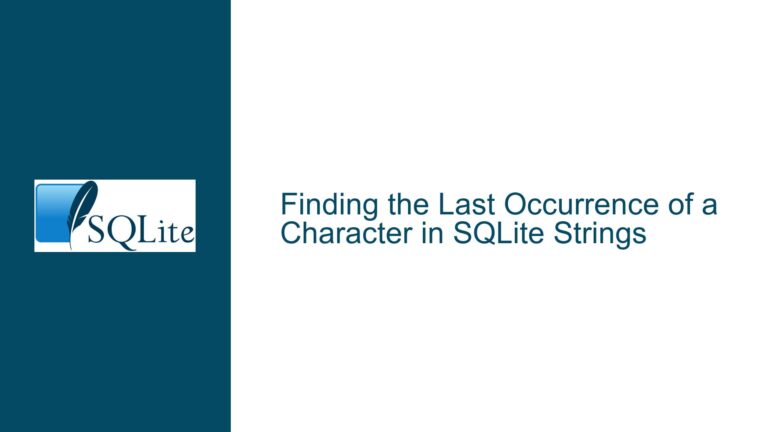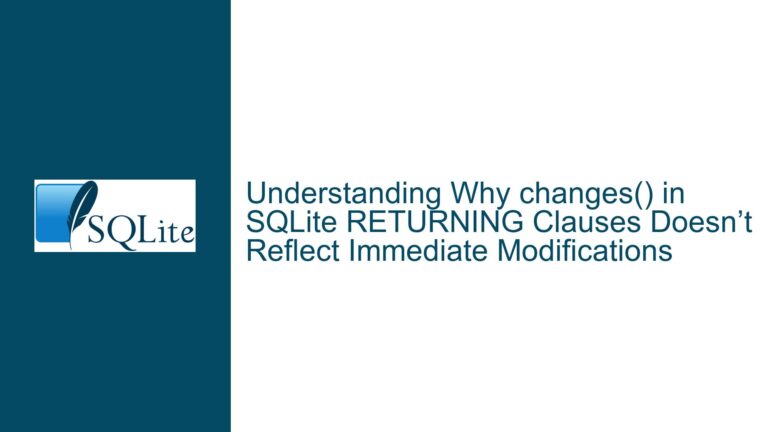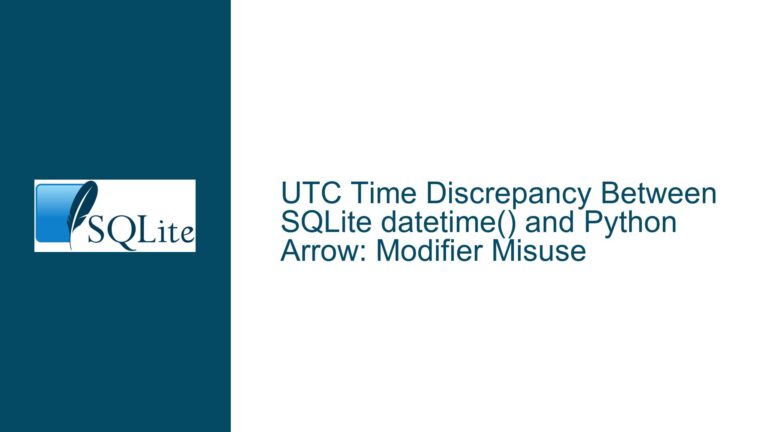Implementing Standard-Compliant FETCH FIRST Syntax in SQLite Queries
Issue Overview: SQLite’s LIMIT Clause vs. Standard FETCH FIRST Syntax
SQLite’s current mechanism for limiting query results relies on the LIMIT and OFFSET clauses, which deviate from the SQL standard’s FETCH FIRST n ROWS ONLY syntax. This discrepancy creates challenges for developers aiming to write database-agnostic SQL code or migrate queries between systems like Oracle, PostgreSQL, SQL Server, and SQLite. The LIMIT clause, while functional, introduces syntactic incompatibility with the majority of relational database management systems (RDBMS) that adhere to the SQL standard.
The SQL standard defines FETCH FIRST n ROWS ONLY as the canonical method for result set truncation, often paired with ORDER BY to enforce deterministic ordering. For example, a standard-conforming query to retrieve the top 10 highest-paid employees would be structured as:
SELECT employee_id, salary
FROM employees
ORDER BY salary DESC
FETCH FIRST 10 ROWS ONLY;
In contrast, SQLite requires:
SELECT employee_id, salary
FROM employees
ORDER BY salary DESC
LIMIT 10;
While functionally equivalent, the syntactic difference complicates cross-database compatibility. Tools and frameworks generating SQL for multiple backends must account for this divergence, often through conditional logic or query rewriting. The absence of FETCH FIRST in SQLite also impacts developers testing queries intended for other databases, forcing manual translation of syntax.
A secondary concern involves advanced features like WITH TIES, supported by some RDBMS (e.g., SQL Server, Oracle). This clause includes additional rows that match the last row’s values in the ordered result set. For instance:
SELECT product_id, revenue
FROM sales
ORDER BY revenue DESC
FETCH FIRST 5 ROWS WITH TIES;
This query returns the top five revenue-generating products and any others with the same revenue as the fifth row. SQLite lacks native support for WITH TIES, necessitating complex subqueries or window functions to achieve similar results.
The core issue extends beyond syntax to encompass broader themes of interoperability, testing efficiency, and adherence to evolving SQL standards. Developers working in multi-database environments face increased cognitive load and code duplication due to these disparities. While SQLite’s lightweight design and embedded nature justify some divergence, the growing emphasis on polyglot persistence architectures amplifies the need for standardized syntax support.
Possible Causes: Why SQLite Lacks FETCH FIRST and WITH TIES Support
Historical Implementation Choices
SQLite’s original design prioritized simplicity and minimalism, borrowing syntax elements from PostgreSQL, which initially popularized the LIMIT/OFFSET clauses. At the time of SQLite’s creation (2000), the SQL:1999 standard’s FETCH FIRST clause was less widely adopted. PostgreSQL itself only added FETCH FIRST support in version 8.4 (2009), years after SQLite’s LIMIT implementation. This historical precedent entrenched LIMIT as SQLite’s default result-limiting mechanism, creating a legacy syntax burden.
Parser Complexity and Maintenance
Introducing FETCH FIRST and WITH TIES would require modifying SQLite’s SQL parser, which is hand-coded for performance and compactness. The parser’s current structure treats LIMIT and OFFSET as optional components of the SELECT statement’s tail end. Adding alternative clauses like FETCH FIRST necessitates:
- Expanding the grammar rules in the parse.y file.
- Updating the tokenizer to recognize new keywords.
- Modifying the code generator to map the new syntax to existing logic for result limitation.
For example, the existing code path for LIMIT involves the Expr structure storing the limit and offset values. Supporting FETCH FIRST would require translating this syntax into the same underlying Expr fields without introducing regressions in query processing.
Prioritization of Stability Over Syntax Expansion
The SQLite development team emphasizes reliability and backward compatibility, often deprioritizing syntactic sugar that doesn’t enhance functionality. Features like WITH TIES introduce new behaviors (e.g., returning additional tied rows), which would require changes to the query optimizer and execution engine. Implementing this correctly demands rigorous testing to handle edge cases, such as ties in unordered queries or when OFFSET is applied.
Community Contribution Dynamics
While SQLite accepts contributions, the bar for merging new features is exceptionally high. Syntax additions must prove their utility without compromising the codebase’s stability or violating the “one way to do it” philosophy. A proposal to add FETCH FIRST would need to demonstrate compelling advantages over the existing LIMIT clause, such as measurable improvements in cross-database compatibility for a significant user base.
Troubleshooting Steps, Solutions & Fixes: Bridging the Syntax Gap
Workaround 1: Adopt LIMIT/OFFSET with Cross-Database Abstraction Layers
For projects requiring immediate compatibility, use abstraction libraries that translate standard SQL into dialect-specific syntax. Tools like SQLAlchemy (Python) or Hibernate (Java) can generate LIMIT clauses for SQLite while emitting FETCH FIRST for other databases. For instance, SQLAlchemy’s Select.limit() method automatically adjusts the syntax based on the dialect:
from sqlalchemy import create_engine, select, Table, MetaData
engine = create_engine('sqlite:///employees.db')
employees = Table('employees', MetaData(), autoload_with=engine)
query = select(employees.c.employee_id, employees.c.salary).order_by(employees.c.salary.desc()).limit(10)
print(query.compile(engine))
This generates LIMIT 10 for SQLite but would produce FETCH FIRST 10 ROWS ONLY when connected to PostgreSQL.
Workaround 2: Preprocess Queries with Custom Scripts
Developers can preprocess SQL files, replacing FETCH FIRST with LIMIT before executing them against SQLite. A simple Python script using regular expressions might transform:
FETCH FIRST (\d+) ROWS ONLY
to:
LIMIT \1
This approach works for basic cases but risks false positives in complex queries (e.g., FETCH FIRST inside string literals). A more robust solution leverages SQL parsers like sqlglot or pg_query to analyze and rewrite syntax trees accurately.
Workaround 3: Emulate WITH TIES Using Window Functions
To replicate WITH TIES behavior in SQLite, use the RANK() window function:
WITH ranked_sales AS (
SELECT product_id, revenue, RANK() OVER (ORDER BY revenue DESC) as rank
FROM sales
)
SELECT product_id, revenue
FROM ranked_sales
WHERE rank <= 5;
This query includes all products with a rank less than or equal to 5, effectively including ties. However, it’s less efficient than native WITH TIES support, as it computes ranks for all rows.
Solution 1: Propose a Patch to SQLite’s Parser
For developers capable of modifying SQLite’s source code, adding FETCH FIRST support involves:
- Extending the Grammar: In parse.y, add new syntax rules:
%type FETCH_CLAUSE {Expr*}
%destructor FETCH_CLAUSE {sqlite3ExprDelete(pParse->db, $$);}
fetch_clause(A) ::= FETCH FIRST expr(X) ROWS ONLY. {A = X;}
| OFFSET expr(X) FETCH FIRST expr(Y) ROWS ONLY. {A = sqlite3PExpr(pParse, TK_OFFSET, X, Y);}
orderby_opt(A) ::= . {A = 0;}
| ORDER BY sortlist(X) fetch_clause(Y). {A = X; /* Handle Y as LIMIT/OFFSET */}
- Updating the Code Generator: Ensure the
FETCH_CLAUSEnodes populate theiLimitandiOffsetfields of theSelectstructure, mirroringLIMIT/OFFSEThandling. - Testing: Validate edge cases, such as combining
FETCH FIRSTwithOFFSETin different orders, and verify that query optimization remains unaffected.
Solution 2: Advocate for Standard Syntax via User Voice Channels
The SQLite team considers user feedback when prioritizing features. Developers can:
- File a formal feature request at SQLite’s GitHub repository, detailing use cases where
FETCH FIRSTimproves interoperability. - Cite adoption statistics from DB-Engines or Stack Overflow surveys to underscore the prevalence of standard syntax.
- Propose a compromise, such as a compile-time flag (e.g.,
-DSQLITE_ENABLE_FETCH_FIRST) to include the feature without bloating the default build.
Solution 3: Leverage SQLite’s Run-Time Loadable Extensions
While SQLite’s parser isn’t extensible via loadable extensions, developers can override the sqlite3_exec() function to intercept and rewrite queries before execution. A proof-of-concept extension could:
- Use a regular expression to identify
FETCH FIRST n ROWS ONLYpatterns. - Replace them with
LIMIT n. - Pass the modified query to the native SQLite engine.
This approach incurs runtime overhead but provides a temporary bridge until native support is implemented.
Long-Term Fix: Collaborate on a Community-Driven Fork
If official adoption is delayed, a community-maintained fork of SQLite could implement FETCH FIRST and WITH TIES, serving as a testbed for eventual upstream integration. This fork would need to:
- Maintain strict compatibility with SQLite’s core features.
- Include comprehensive test cases for the new syntax.
- Document performance characteristics, especially for
WITH TIESemulation.
Performance Considerations When Migrating from LIMIT to FETCH FIRST
While syntactically different, both clauses trigger identical query execution paths in SQLite. The optimizer applies the same cost-based decisions regardless of whether LIMIT or FETCH FIRST is used. However, developers should verify that indexing strategies align with ORDER BY clauses to avoid full-table scans when limiting results. For example, an index on employees(salary DESC) accelerates both:
SELECT employee_id, salary FROM employees ORDER BY salary DESC LIMIT 10;
and
SELECT employee_id, salary FROM employees ORDER BY salary DESC FETCH FIRST 10 ROWS ONLY;
Best Practices for Pagination Without OFFSET
The forum discussion cautions against using OFFSET for pagination due to performance degradation on large datasets. Instead, use keyset pagination:
-- First page
SELECT * FROM orders ORDER BY order_date, order_id LIMIT 100;
-- Next page (using last seen order_date and order_id)
SELECT * FROM orders
WHERE (order_date, order_id) > (?, ?)
ORDER BY order_date, order_id
LIMIT 100;
This method leverages indexed columns to skip rows efficiently, avoiding the cumulative slowdown of OFFSET. SQLite’s LIMIT clause remains adequate for this pattern, but FETCH FIRST adoption would standardize syntax across databases.
By addressing the syntax gap through a combination of immediate workarounds and long-term advocacy, developers can mitigate interoperability issues while maintaining SQLite’s performance and reliability benefits.






